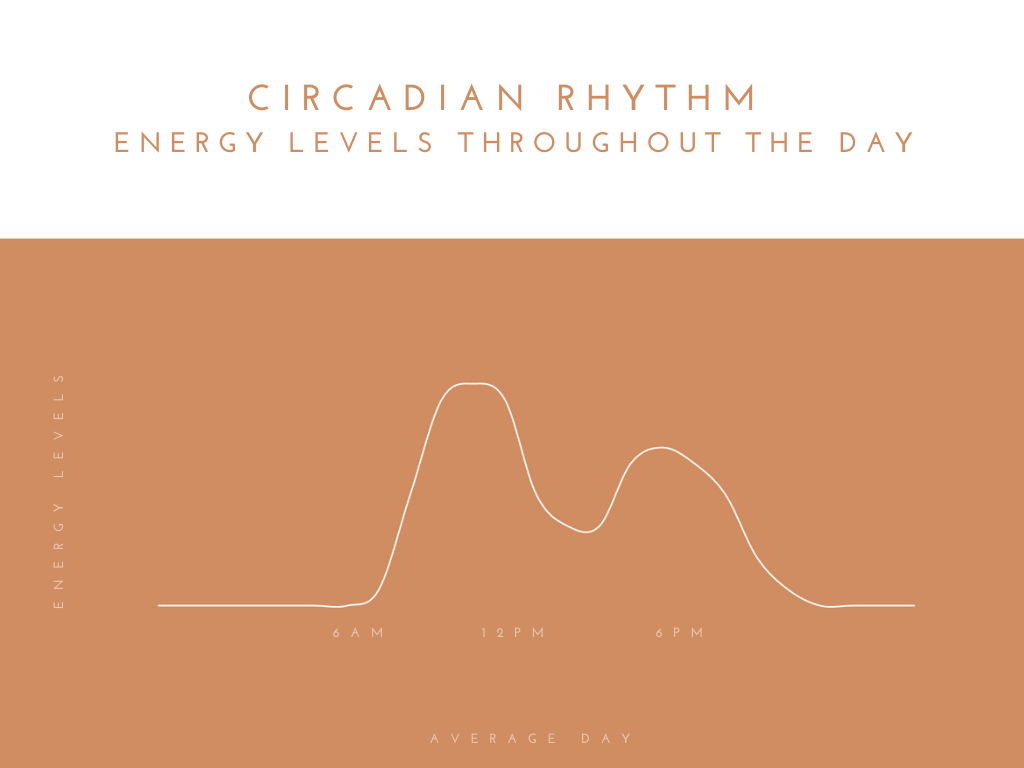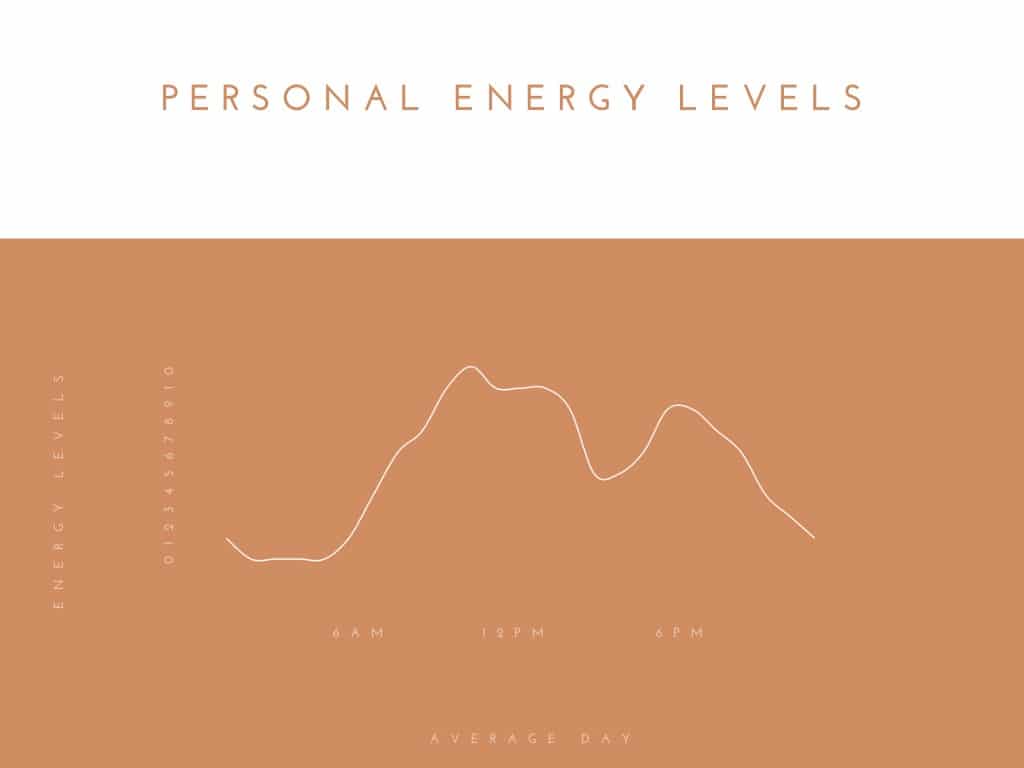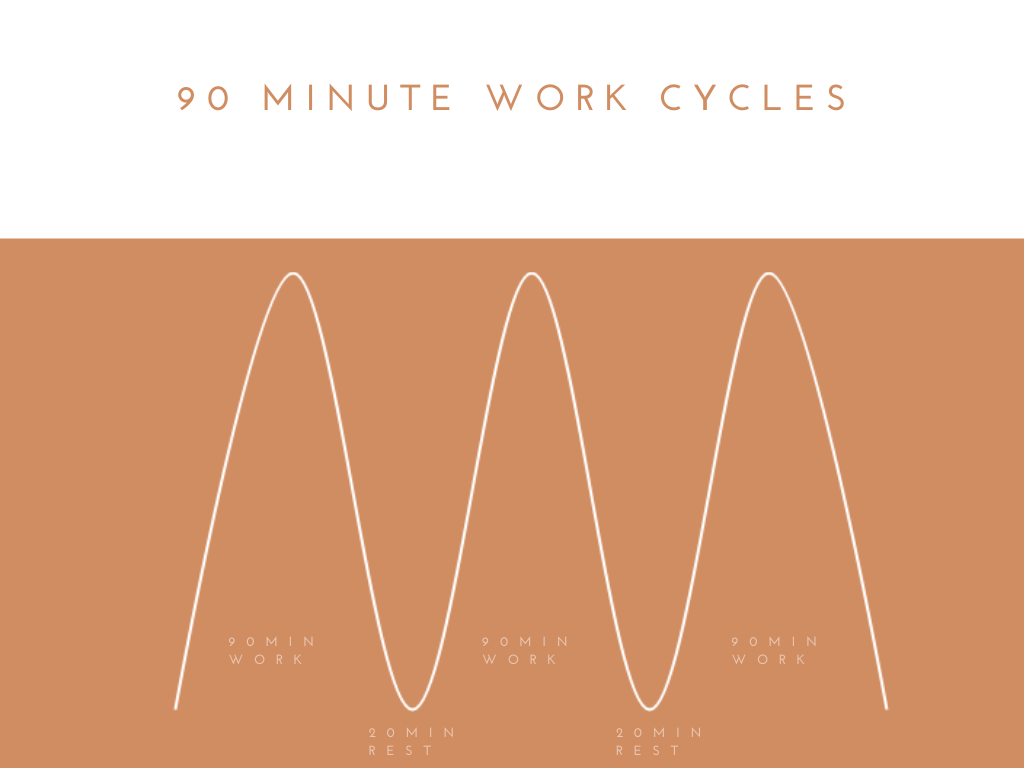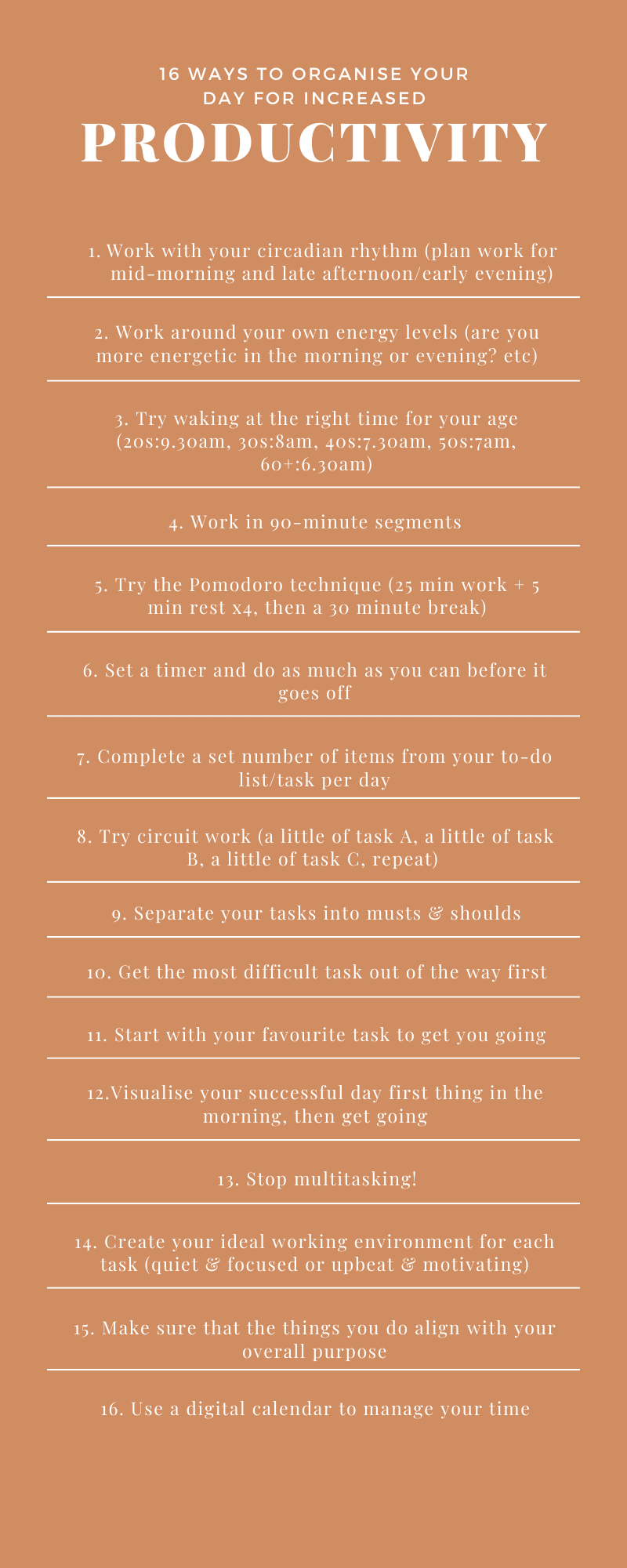Be Organised To Increase Productivity
Work with your body and personality type and get more from each day with these tried and tested tips and techniques.
LAST UPDATED: 07/05/2021
I love learning about different ways to plan my day. I aim to increase both productivity and well-being by working with my body and personality type. I’ve read about and tried each of the following techniques, removing or tweaking them to improve my routine. Hopefully, some of them will help you make the most of your day. Since everyone is unique, the aim is to pick and choose what feels good to you.
1. Work with your circadian rhythm
Our circadian rhythm is our body’s natural way of regulating our sleep/wake cycle over roughly 24 hours. We naturally feel more awake at some times of the day than others. If we work with this rather than against it, we can make the most of those times when our body feels energetic and our mind more able to focus.
The following image shows how the average person’s energy levels generally fluctuate throughout the day:

As you can see here, most of us wake up a little tired, but hopefully not too tired if we’ve slept well enough. Our energy rises quite quickly, reaching a peak around three hours after we wake. It then declines from around midday through to lunchtime. After lunch, we experience a dip in energy known as the afternoon slump. We’re likely to feel lethargic and in need of a nap, or if we’re at work, we may be watching the clock looking forward to home time. Luckily our body recovers from this slump and we have a second wave starting in the late afternoon and lasting through to around dinner time. Our energy then declines from dinner onwards until around 10 pm when we should feel ready to sleep.
We can make the most of this natural rise and fall of our energy by planning our most mentally and physically straining tasks for mid-morning or later afternoon/evening. We could then schedule less strenuous tasks such as shopping, relaxing, socialising or general admin for those in-between periods.
Circadian rhythm daily schedule:
- 7:00 AM – 10:00 AM: Fairly easy morning tasks
- 10:00 AM – 1:00 PM: Mentally and physically demanding tasks (our core work)
- 1:00 PM – 4:00 PM: Easy tasks/admin and/or relaxing
- 4:00 PM – 7:00 PM: Second wave of mentally/physically demanding tasks
- 7:00 PM – 10:00 PM: Winding down
2. Work with your personal energy flow
The circadian rhythm gives a good overview of the average person’s energy flow throughout the day. But it doesn’t take into account that some people are night owls, some morning people etc. Our bodies are all unique with slightly different energy flows.
So while the circadian rhythm gives a good indication of how you might feel throughout the day, it may be worth noting your personal energy levels. To do this, you can rate your energy on a scale of 1-10 for each hour of the day. Use your findings to plan your activities around your unique energy flow.
Your energy chart might look a little bit like this:

3. Wake at the right time for your age
Research shows that as we age, we benefit from waking up at different times.
We tend to rise early as children. Then, as teenagers and young adults, we benefit from sleeping in longer. From the age of 30 onwards, we gradually start waking earlier and earlier. By retirement age, we’ll likely find we wake at a similar time as we did when we were children.
Try waking up at the following time for improved energy:
Children: 7am
Teenagers: 10am
20-somethings: 9.30am
30-somethings: 8am
40-somethings: 7.30am
50-somethings: 7am
60+: 6.30am
The idea is that by following our body’s inclination to waking up at different times depending on our age, we’ll wake easier and with more energy.
So if you do have the ability to choose your own wake-up time, it might be worth trying it out for a little while to see if it helps.
4. Work in 90-minute segments
There are smaller wake/sleep cycles within our 24-hour circadian rhythm cycle. They are around 2 hours long and follow a pattern of 90 minutes of ‘wake’ energy, followed by 20-30 minutes of ‘sleep’ energy.

You could use this 90/30 cycle to plan activities throughout your day, breaking demanding tasks into 90-minute chunks, with a short rest or admin break in between.
5. Try the Pomodoro Technique
The Pomodoro Technique is a time management method developed in the 1980s to increase mental performance.
According to the technique, we increase our focus by working in 25-minute segments, with 5-minute breaks in between. After repeating this cycle four times, you’d need a 20-35 minute rest break before starting again.
If you were to follow the Pomodoro Technique, your working day might look a little bit like this:
The Pomodoro Technique:
- 25 minutes work, 5-minute break
- 25 minutes work, 5-minute break
- 25 minutes work, 5-minute break
- 25 minutes work, 20-35 minute break
- Repeat
6. Try setting a timer
If you find it hard to get started with a task, it can help to have an endpoint in mind. You set a timer, do as much as you can during that time, and when the alarm goes off, you’re finished. It makes the task feel more like a game as you’re trying to see how much you can do before the timer goes off.
Another way you could use the timer technique is to make the most of advert/commercials in the evening while you’re watching television. Rather than skipping through an advert, use the time to do something productive, such as wiping the kitchen sides down or getting your lunch or clothes ready for the following day. Those little “breaks” throughout our day create large chunks of productivity if we use them wisely.
7. Complete a set number of tasks/items
If you’ve got a non-urgent task, such as a message cupboard, it can help to pick a set amount of items to tackle at a time. You might choose to tidy up 20 or 30 things a day.
It works similarly to if you’re at the gym and counting to 20 sit-ups. A number goal can be more motivating for some than a time goal.
8. Do circuit work
The number technique is not the only one that’s drawn from exercise. People often exercise in circuits, doing several repetitions before moving onto a different activity, then the next, repeating this circuit again and again for the duration of the workout. You can apply this circuit method to a list of chores or housework.
A tip for working this way is to create a circuit with both easy and not so easy tasks. It’s a great way of making sure you get round to doing those jobs you hate. I love working in circuits.
Circuit work:
- A bit of task A
- A bit of task B
- A bit of task C
- A bit of task D
- Repeat
9. Separate your tasks into musts and shoulds
There are never enough hours in the day to get everything done. So make sure you separate your to-do list into things that absolutely must get done and things that you could or should get done. Then start with the priority tasks.
10. Start with the task you least want to do
Another tip is to start your day by doing the task you want to do least. If you get that out the way, the rest of your day should be more enjoyable. This method boosts your self-confidence as you start to trust that you can get even the worst tasks done. It might also motivate you to do other jobs you’ve been putting off.
This method complements our circadian rhythm in that we’d be doing the most strenuous task during our first block of core work.
11. Start with the task you most want to do
I’m not saying that you should start every day by reading for three hours with a coffee and a croissant. But that there’s no harm in taking your list of musts and beginning with the one you most feel like doing, working your way through the list like that. I like to call this method ‘following your bliss’ as it feels pleasant and natural to go with the flow.
You’ll likely feel very positive working this way, and this positivity might make you more inclined to work on some tasks you’ve been putting off. Just make sure you don’t end up carry over your least favourite task day after day, else you’ll never get it done.
12. Visualise your successful day
Before you go to bed, or in the first few minutes after waking, visualise how your best self our behave in the upcoming day.
See yourself doing all the things you want to get done and enjoy how it feels. This technique aligns you with your highest self and is a great motivator.
13. Stop multitasking
We work better when we do a single task with full attention. You may feel you’re able to do more than one thing at once, but single-tasking gets the job done faster and to a higher standard. You’ll also enjoy doing it more, as we’re generally happier when we’re present and single-tasking than when we’re thinking of too many things at once.
14. Figure out your best working style
Do you get swept up in the energy rush of fast-paced work, often with upbeat music and in a vibrant and uplifting environment? Or are you someone who prefers to work slowly, methodically and quietly? Or there could be a time and place for both. Figure out what works best for you for each task and align your environment so that you take advantage of it.
15. Align yourself with your purpose
If you frequently find your days filled with things you either hate doing, hate giving your attention to, you’re not interested in, or that make you feel bored, lazy, stressed or tired, it might be time to re-think your purpose. We’re more productive when we’re doing what we’re passionate about and when we’re taking good care of our well-being.
16. Manage your time with a digital (not paper) calendar
I know, I know. Paper diaries as just so beautiful! But hear me out. Most of what we do day-to-day is repetitive. With a digital calendar, you can set tasks to repeat on a schedule, rather than having to re-add them every time.
Other benefits include the ability to add notes, reminders and locations. Digital calendars are also better for the planet.
I’ll go on. You can also colour code your digital calendar, assigning a colour to each type of task. I use green for healthy activities, yellow for social, orange for self-care tasks, blue for appointments and admin etc. If you’re still not sold on using a digital calendar, you could always buy coloured stickers for your paper diary. It’s so helpful to view your activities at a glance.
I hope some of these techniques and tips help you. If you have any that you’d like to share with me, please get in touch using the comments box below.
